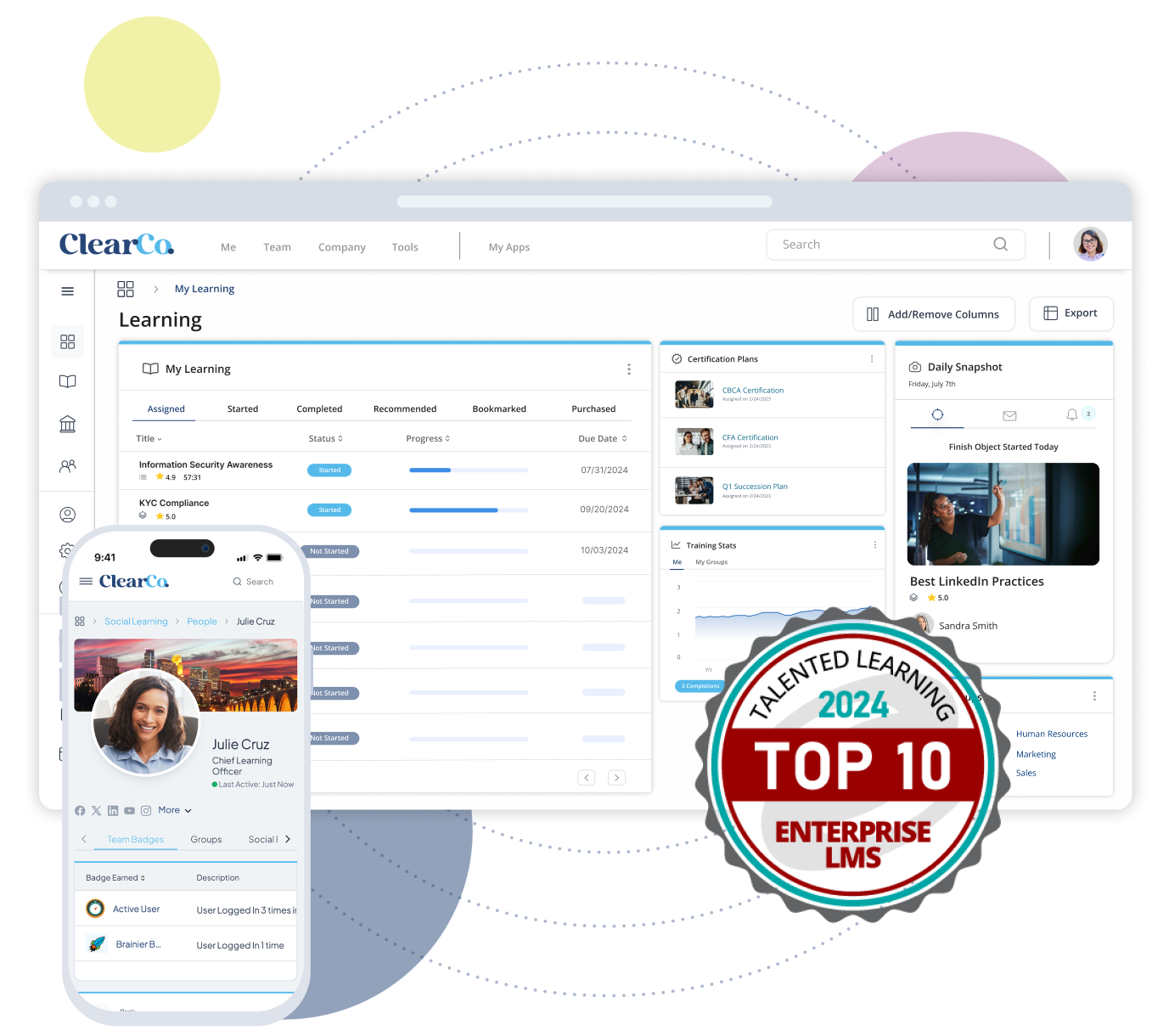Your company’s ability to reach its goals — and keep top talent — now hinges on one critical factor: developing employee skills. As global skills gaps widen and change accelerates, a continuous learning and development (L&D) strategy is the only way to stay competitive and resilient. Ongoing learning is the foundation for innovation, agility, and sustained business performance.
Continuous learning is critical in 2026 and beyond because it helps companies:
- Combat skills shortages: 75% of employers already report trouble filling roles, with an estimated 85 million jobs projected to be unfilled by 2030. L&D ensures your employees’ skills will help your business succeed.
- Boost L&D ROI: Companies are doubling down on training, increasing budgets by nearly 12%. Investing strategically in employee L&D leads to higher productivity, innovation, and profitability.
- Drive growth with AI-driven personalization: With AI-powered tools, companies are delivering hyper-personalized learning experiences that reduce training time by 40% and ensure employees receive the most relevant and timely content for their roles.
- Accelerate skill development with microlearning: Microlearning delivers quick, focused lessons exactly when employees need them. Companies using this approach report better knowledge retention and immediate application on the job. Microlearning helps teams adapt faster to new challenges.
- Strengthen core soft skills: The pace of change has never been faster, making adaptability, resilience, and emotional intelligence more important than ever. Companies that prioritize these skills see stronger leadership, better collaboration, and a more agile response to market shifts. For example, investing in emotional intelligence training leads to higher employee retention and a competitive edge during disruptive times.
- Attract and retain top talent: A strong L&D program makes your company more appealing to job seekers and keeps current talent engaged — and employee development statistics back it up. 86% say they’d leave their current roles for one with continuous learning opportunities. Companies like Amazon and Accenture have shown that investing in reskilling and upskilling attracts ambitious talent and reduces turnover by showing employees that their personal growth matters.
Building a culture of continuous learning is the most reliable way to drive engagement, retention, and ongoing success. Read on to see how your business can lead the way in 2026.
What Is Continuous Learning in the Workplace?
Continuous learning at work is exactly what it sounds like — frequent, ongoing learning opportunities for employees to develop new knowledge, skills, and abilities. While most workplaces offer employee training, workshops, and courses, a culture of continuous learning requires going beyond the usual. It’s more intentional and ingrained into daily life at work.
Continuous learning means that your people have the encouragement, support, and guidance they need to grow their skills and knowledge regularly. It means providing lifelong learning opportunities throughout their employee journey, helping them explore their strengths and interests, and creating a plan for their long-term career growth.
You can support learning and development (L&D) with technology, personalization, and relationships:
- AI-Powered Learning Platforms: Modern learning management systems (LMS) use AI to deliver personalized, on-demand training. By analyzing employee progress, these platforms adapt lessons to meet individual needs, making skill-building more effective and efficient.
- Microlearning Modules: Short, focused lessons, or microlearning, is delivered on mobile devices and accessible in real time. These highly specific courses ensure employees learn the new skills they need, when they need them. Quick, accessible training makes it easier to retain those skills and fits seamlessly into busy schedules.
- Performance-Driven Learning Paths: Training programs that align with performance goals ensure your employees get the right development opportunities at the right time. They get more relevant, timely recommendations, making L&D more impactful and driving real results.
- Comprehensive Talent Management Software: Integrated platforms that combine learning, performance tracking, and career development tools help companies streamline employee growth. These systems give HR and L&D leaders a holistic view of talent, making it easier to identify skill gaps and create targeted development plans.
- Mentorship Programs: Mentorships are a chance for less experienced team members to learn from their more seasoned colleagues. Mentors share their knowledge and help mentees build skills while also passing on a deeper understanding of the company's culture and history. A formal mentorship program gives your people ownership over company culture and their own career trajectory.
Continuous learning for employees is a practical approach to keeping your team agile, engaged, and ready for what’s next. With the right tools and strategies in place, it becomes a natural part of the workday.
So, what’s in it for your organization? Let’s dive into the benefits.
The Benefits of Continuous Learning
Continuous learning is not just about preparing employees for promotions or teaching them how to use a new piece of equipment. It’s about driving company performance by empowering every person to pursue learning, however it looks for them. Continuous learning is what sets truly great companies apart from the rest and defines the most innovative leaders in their industries.
For employees, the benefits of continuous learning include:
- Career growth and new job opportunities, including internal promotions
- Skill acquisition and improvement
- Higher levels of engagement and job satisfaction
- Staying competitive in their field
Organizations that support a culture of learning benefit from:
- Improved performance and engagement
- Increased productivity and creativity that lead to innovation
- Decreased talent turnover
- Resiliency to weather instability caused by industry trends and market changes
This is only a glimpse of the possibilities that come with a culture where learning is a priority. Besides the many benefits of ongoing learning, the fact that your competitors are taking notice of employee L&D means it should be a top initiative for you, too. Investing in ongoing employee training doesn’t just boost engagement — it pays real dividends.
In fact, companies that offer structured training programs see income per employee increase by 218% compared to those without. That’s a powerful reminder of the business impact that continuous learning can have.
How to Implement Continuous Learning Experiences
Follow these best practices to make continuous learning part of your company culture.
4 Types of Continuous Learning Strategies
You can support continuous learning for employees with a combination of several strategies:
- Formal Learning Plans: Structured education programs like standard training courses, professional certifications, and continuing education
- Informal Learning: On-the-job learning, peer-to-peer knowledge sharing, and mentorships
- Social Learning: Using collaborative tools and networks to discuss and share information
- Self-Directed Learning: Driven by employees themselves — they leverage resources to identify strengths, create career paths, and find opportunities to upskill or reskill
Find Skills Gaps & Strengths
A skills gap analysis shows you the skills your organization needs versus the skills your employees currently have. Use tools like surveys, focus groups, and performance reviews to gather insights from your workforce. Shining a light on skills gaps enables you to focus your L&D efforts on the most critical areas.
Know, Know, Know Your Goals
Define clear, measurable learning goals that align with those of the business. Are you looking to increase technical expertise on the engineering team or improve leadership skills for managers? Chances are, those goals resonate with many of your employees, too. You can build personalized learning paths and tie their goals to company goals to power individual and business success.
Use Technology for Support
Technology is the secret to scalable and seamless continuous learning. A powerful LMS like ClearCompany Learning, powered by Brainier, allows you to design, deliver, and track learning programs. Features like AI-powered recommendations personalize learning experiences, ensuring employees receive content that fits their roles, goals, and learning styles.
Recognize & Reward Learning
When learning is encouraged and celebrated, it becomes part of your company culture. Recognize employees who complete training or upskilling programs, and consider offering incentives like certifications or career advancement opportunities.
Watch & Evolve
Continuous learning is not static. With an LMS, you have access to in-depth analytics and can quickly gather feedback on employee engagement and the effectiveness of your L&D programs. Are employees applying their new skills? Are they feeling more engaged and supported after learning opportunities increased?
Keep an eye on important metrics and feedback around employee L&D, and stay in tune with business goals. Refine your learning initiatives often so they’re always relevant and impactful as your company evolves.
When you use a modern LMS to support continuous learning, you can uncover answers to essential strategic questions:
- How do employees’ current skill sets compare to your company’s skill gaps?
- Which of your employees show signs of leadership potential or are good candidates for upskilling?
- Which learning resources are most popular, and which are the most effective?
- How quickly are employees becoming proficient in new skills? Has it had an impact on their work?
- Which departments or roles are most in need of training to stay competitive?
With answers to insightful questions like these, you can make the best possible decisions about how to help your employees learn and grow. Drive innovation, increase engagement, and future-proof your organization with a culture of continuous learning.
ClearCompany Learning is the essential platform for supporting continuous employee L&D. Find out how we can help you build a culture of constant learning and growth when you sign up for a demo of ClearCompany.



